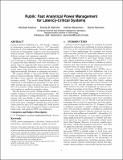| dc.contributor.author | Kasture, Harshad | |
| dc.contributor.author | Bartolini, Davide Basilio | |
| dc.contributor.author | Beckmann, Nathan Zachary | |
| dc.contributor.author | Sanchez, Daniel | |
| dc.date.accessioned | 2017-10-27T15:00:48Z | |
| dc.date.available | 2017-10-27T15:00:48Z | |
| dc.date.issued | 2015-12 | |
| dc.identifier.issn | 978-1-4503-4034-2 | |
| dc.identifier.uri | http://hdl.handle.net/1721.1/111984 | |
| dc.description.abstract | Latency-critical workloads (e.g., web search), common in datacenters, require stable tail (e.g., 95th percentile) latencies of a few milliseconds. Servers running these workloads are kept lightly loaded to meet these stringent latency targets. This low utilization wastes billions of dollars in energy and equipment annually.
Applying dynamic power management to latency-critical workloads is challenging. The fundamental issue is coping with their inherent short-term variability: requests arrive at unpredictable times and have variable lengths. Without knowledge of the future, prior techniques either adapt slowly and conservatively or rely on application-specific heuristics to maintain tail latency.
We propose Rubik, a fine-grain DVFS scheme for latency-critical workloads. Rubik copes with variability through a novel, general, and efficient statistical performance model. This model allows Rubik to adjust frequencies at sub-millisecond granularity to save power while meeting the target tail latency. Rubik saves up to 66% of core power, widely outperforms prior techniques, and requires no application-specific tuning.
Beyond saving core power, Rubik robustly adapts to sudden changes in load and system performance. We use this capability to design RubikColoc, a colocation scheme that uses Rubik to allow batch and latency-critical work to share hardware resources more aggressively than prior techniques. RubikColoc reduces datacenter power by up to 31% while using 41% fewer servers than a datacenter that segregates latency-critical and batch work, and achieves 100% core utilization. | en_US |
| dc.description.sponsorship | National Science Foundation (U.S.) (Grant CCF-1318384) | en_US |
| dc.language.iso | en_US | |
| dc.publisher | Association for Computing Machinery (ACM) | en_US |
| dc.relation.isversionof | http://dx.doi.org/10.1145/2830772.2830797 | en_US |
| dc.rights | Creative Commons Attribution-Noncommercial-Share Alike | en_US |
| dc.rights.uri | http://creativecommons.org/licenses/by-nc-sa/4.0/ | en_US |
| dc.source | MIT Web Domain | en_US |
| dc.title | Rubik: fast analytical power management for latency-critical systems | en_US |
| dc.type | Article | en_US |
| dc.identifier.citation | Kasture, Harshad, et al. “Rubik: fast analytical power management for latency-critical systems.” Proceedings of the 48th International Symposium on Microarchitecture (MICRO-48), December 5-9 2015, Waikiki, Hawaii, USA, Association for Computing Machinery (ACM), December 2015 © 2015 Association for Computing Machinery (ACM) | en_US |
| dc.contributor.department | Massachusetts Institute of Technology. Computer Science and Artificial Intelligence Laboratory | en_US |
| dc.contributor.department | Massachusetts Institute of Technology. Department of Electrical Engineering and Computer Science | en_US |
| dc.contributor.mitauthor | Kasture, Harshad | |
| dc.contributor.mitauthor | Bartolini, Davide Basilio | |
| dc.contributor.mitauthor | Beckmann, Nathan Zachary | |
| dc.contributor.mitauthor | Sanchez, Daniel | |
| dc.relation.journal | Proceedings of the 48th International Symposium on Microarchitecture (MICRO-48) | en_US |
| dc.eprint.version | Author's final manuscript | en_US |
| dc.type.uri | http://purl.org/eprint/type/ConferencePaper | en_US |
| eprint.status | http://purl.org/eprint/status/NonPeerReviewed | en_US |
| dspace.orderedauthors | Kasture, Harshad; Bartolini, Davide B.; Beckmann, Nathan; Sanchez, Daniel | en_US |
| dspace.embargo.terms | N | en_US |
| dc.identifier.orcid | https://orcid.org/0000-0002-3964-9064 | |
| dc.identifier.orcid | https://orcid.org/0000-0002-6057-9769 | |
| mit.license | OPEN_ACCESS_POLICY | en_US |
